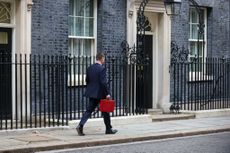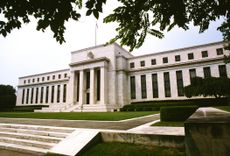The dangers of negative interest rates
Negative interest rates could spark the next financial crisis. And central bankers could end up the object of the public's wrath, says Merryn Somerset Webb.

Who do you blame for the last great financial crisis? Just off the top of your head. I bet the phrase that pops up first is "the banks". If it isn't that, it will be something to do with whoever invented subprime mortgages or started "slicing and dicing" risk.
Unless you are a finance professional, it will not be the regulatory or rate-setting failures of central bankers. In the past decade, they have mostly been portrayed as the saviours of the global economy. Forced by the widespread political failure to provide fiscal stimulus, central bankers went into overdrive and tried to do everything themselves, showering the global economy with easy money and saving the world, and, in European Central Bank president Mario Draghi's case, the euro.
Their use of quantitative easing might have merged fiscal and monetary policy together. (By raising asset prices artificially, QE has wealth distribution implications.) It might have looked more than a little political: the euro is a political project, so doing "whatever it takes" to save it is also political. And it might have some negative side effects but, the story goes, at least monetary policy did its job of preventing a global meltdown.
Subscribe to MoneyWeek
Subscribe to MoneyWeek today and get your first six magazine issues absolutely FREE

Sign up to Money Morning
Don't miss the latest investment and personal finances news, market analysis, plus money-saving tips with our free twice-daily newsletter
Don't miss the latest investment and personal finances news, market analysis, plus money-saving tips with our free twice-daily newsletter
But now the problems they created are becoming obvious, as even Draghi noted in an interview published earlier this week. "The negative side effects as you move forward are more and more visible," he said. Indeed they are.
Take negative interest rates, something that had almost no precedent when first Sweden, Switzerland and then the ECB deployed them after the 2008 crisis. The Swiss National Bank had charged de facto negative rates on non-resident deposits in the 1970s but that was it.
Negative interest rates undermine a country's banks and, by extension, its entire economy. Their effect is visible in the share prices of European banks. The Euro Stoxx banks index is down near the 2012 lows it set during the eurozone crisis. By charging fees for deposits, negative rates turn assets into a kind of liability. That is already visible to some wealthy clients of European banks as well as any one with a business account. There is something shocking about actually seeing interest as a cost set against your cash.
Negative rates also destroy the stability of pension and insurance funds. At a conference in London this week, Peter Spiller of CG Asset Management provided a nasty little example of the damage they can do. Imagine, he said, that you want to have an inflation-adjusted £1 for your retirement in 2068 (49 years away). You could look to achieve this perhaps by investing in a gilt that matures then. Right now, you would need to put in £2.60 for every £1 you get out. Why? Because that is the compounding effect of investing for 49 years on the miserable minus 2.05% yield that the bond is offering investors today.
The effect may not be as visible as negative nominal rates on deposits, but when rates are negative in either real or nominal terms, cash is no longer helpful to anyone saving for retirement. The lower rates go, the more investors feel they must save.
There are less immediately obvious problems stemming from very loose monetary policy. The main one is the huge build up in public and private debt across the developed world (the highest ever in peacetime) and the low quality of much of that debt.
If we were seeing the end of QE and negative interest rates, all these very visible problems could be dismissed as probably temporary and, perhaps, even worth the pain. But we are not.
Draghi is leaving the ECB being hailed as a hero, but he is also leaving it with rates at minus 0.5% and a new round of QE bond buying under way. He isn't alone: in the month of August, a quarter the G20 central banks lowered their policy rates. And the chat among central bankers is not about how to end it but instead how to make it even more extreme to address the next recession. Chairman Jay Powell recently asked whether the US Federal Reserve should be expanding its tool kit.
Interest rates can go lower. Outside Japan and the eurozone, most are still in positive territory. And central banks can go direct: merging monetary and fiscal policy with various versions of helicopter money. It might work.
But this time it might come back to bite. Most people didn't notice the role of the central banks in the last financial crisis. Why would they? Old style monetary policy was important but it was also complicated and boring and hence more or less invisible.
But negative rates are a different thing altogether. While you can explain the problems they create in complicated ways, there is no need to do so. Most people intuitively feel that negative interest is somehow unnatural. If negative rates cause the next crisis by distorting capital allocation and encouraging unmanageable levels of debt, central bankers will discover that the real danger is to them personally. The whole idea that they are politically independent good guys will come tumbling down.
Instead ordinary people will see them as dangerous creatives who set in motion an experiment they have no way of reversing or controlling. Just like the bankers in the early 2000s.
- This article was first published in the Financial Times
Merryn Somerset Webb started her career in Tokyo at public broadcaster NHK before becoming a Japanese equity broker at what was then Warburgs. She went on to work at SBC and UBS without moving from her desk in Kamiyacho (it was the age of mergers).
After five years in Japan she returned to work in the UK at Paribas. This soon became BNP Paribas. Again, no desk move was required. On leaving the City, Merryn helped The Week magazine with its City pages before becoming the launch editor of MoneyWeek in 2000 and taking on columns first in the Sunday Times and then in 2009 in the Financial Times
Twenty years on, MoneyWeek is the best-selling financial magazine in the UK. Merryn was its Editor in Chief until 2022. She is now a senior columnist at Bloomberg and host of the Merryn Talks Money podcast - but still writes for Moneyweek monthly.
Merryn is also is a non executive director of two investment trusts – BlackRock Throgmorton, and the Murray Income Investment Trust.
-
 Should you invest in UK equities?
Should you invest in UK equities?The FTSE 100 hit a record high this week, but UK equities remain unloved and undervalued compared to their global and US peers. Should you snap them up at a discount?
By Katie Williams Published
-
 State pension errors: DWP urged to check for mistakes among divorced people
State pension errors: DWP urged to check for mistakes among divorced peopleFormer pensions minister Steve Webb says there are a high number of divorced women on low state pensions. Now MPs want the DWP to check if there were any errors in “potentially underpaying men and women who are divorced”.
By Ruth Emery Published
-
 UK wages grow at a record pace
UK wages grow at a record paceThe latest UK wages data will add pressure on the BoE to push interest rates even higher.
By Nicole García Mérida Published
-
 Trapped in a time of zombie government
Trapped in a time of zombie governmentIt’s not just companies that are eking out an existence, says Max King. The state is in the twilight zone too.
By Max King Published
-
 America is in deep denial over debt
America is in deep denial over debtThe downgrade in America’s credit rating was much criticised by the US government, says Alex Rankine. But was it a long time coming?
By Alex Rankine Published
-
 UK economy avoids stagnation with surprise growth
UK economy avoids stagnation with surprise growthGross domestic product increased by 0.2% in the second quarter and by 0.5% in June
By Pedro Gonçalves Published
-
 Bank of England raises interest rates to 5.25%
Bank of England raises interest rates to 5.25%The Bank has hiked rates from 5% to 5.25%, marking the 14th increase in a row. We explain what it means for savers and homeowners - and whether more rate rises are on the horizon
By Ruth Emery Published
-
 UK wage growth hits a record high
UK wage growth hits a record highStubborn inflation fuels wage growth, hitting a 20-year record high. But unemployment jumps
By Vaishali Varu Published
-
 UK inflation remains at 8.7% ‒ what it means for your money
UK inflation remains at 8.7% ‒ what it means for your moneyInflation was unmoved at 8.7% in the 12 months to May. What does this ‘sticky’ rate of inflation mean for your money?
By John Fitzsimons Published
-
 VICE bankruptcy: how did it happen?
VICE bankruptcy: how did it happen?Was the VICE bankruptcy inevitable? We look into how the once multibillion-dollar came crashing down.
By Jane Lewis Published